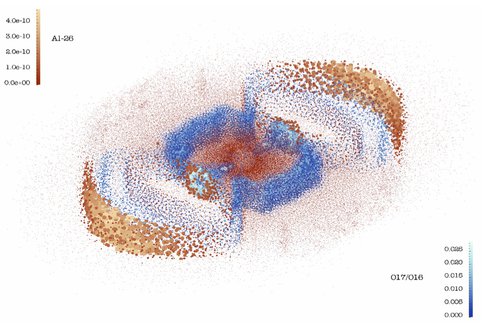2010 Annual Science Report
 Arizona State University
Reporting | SEP 2009 – AUG 2010
Arizona State University
Reporting | SEP 2009 – AUG 2010
Astrophysical Controls on the Elements of Life, Task 6: Determine Which Elemental or Isotopic Ratios Correlate With Key Elements
Project Summary
Many of the elements important to life or to the development of potentially habitable solar systems are difficult or impossible to observe directly. We are working to understand where these elements are produced in stars and whether they correlate with elements that are more easily observed. This effort requires modeling of the dynamics and nuclear burning in supernova explosions to determine what elements are produced together and, equally important, how the ejected material is incorporated into the gas that forms stars and planets. We are also observing a region of star formation to detect the signature of enrichment of newly formed sunlike stars by the explosion of their nearby, more massive cousins.
Project Progress
Investigator Patrick Young and Graduate Student Carola Ellinger, working with Steven Desch, have published the effects of supernova injection of 26Al rich material on oxygen isotopes in the forming solar system. This analysis, combined with results from the Genesis mission, demonstrates that supernova injection is a viable source of 26Al.
Calculations of 3D explosions of massive stars with 106 sph particles have been run to 50-100 years after the supernova explosion. These include explosions for spherical symmetry and four different asymmetric morphologies for two progenitor stars. We are performing 5×107 particle simulations for both progenitors and have applied for time on the Los Alamos Roadrunner system (currently #3 on the list of fastest supercomputers) to perform a 109 particle simulation on 24,000 processors. Higher resolution simulations confirm that the size of ejecta clumps in 106 particle simulations is not a resolution effect. These simulations are suitable for determining which elements are injected into star/planet forming regions by individual clumps.
Postdoctoral Fellow Themis Athanassiadou, with Frank Timmes and Desch, has presented work on injection of material into existing planetary systems by nearby supernovae.
Young and Graduate Student Mike Pagano have received 600 spectra of nearby solar-type stars from the Carnegie Institution of Washington planet search to study element abundance variations. The Scorpius-Centaurus stellar association has subgroups ranging in age from 5 – 15 million years. Young received 3 nights of observing time on the Magellan Telescope to study abundances in the group to provide estimates of how much material has been injected into forming stars by supernovae in older subgroups. Both will yield abundances of ~20 elements, potentially including S, P, and Mo, which are of interest to the Stoichiometry of Life group at ASU. Work from 2009 demonstrated that the Si/S ratio in material rich in 26Al is highly diagnostic. A large sample should show whether this signature is detectable. This is the largest sample of elements obtained for a uniform group of stars.
A thick slice from a 1 million particle simulation of a supernova explosion with full nucleosynthetic calculations, which shows 26Al abundaces in red shades and 17O/16O in blues. Analysis of this and accompanying simulations shows that oxygen isotope ratios in the Solar System are consistent with injection of material from a nearby supernova as a source for 26Al.
Publications
-
Ellinger, C. I., Young, P. A., & Desch, S. J. (2010). COLLATERAL EFFECTS ON SOLAR NEBULA OXYGEN ISOTOPES DUE TO INJECTION OF 26 Al BY A NEARBY SUPERNOVA. The Astrophysical Journal, 725(2), 1495–1506. doi:10.1088/0004-637x/725/2/1495
-
Magkotsios, G., Timmes, F. X., Hungerford, A. L., Fryer, C. L., Young, P. A., & Wiescher, M. (2010). TRENDS IN 44 Ti AND 56 Ni FROM CORE-COLLAPSE SUPERNOVAE. The Astrophysical Journal Supplement Series, 191(1), 66–95. doi:10.1088/0067-0049/191/1/66
- Athanassiadou, T., Desch, S., Fields, B., Ouellette, N. & Timmes, F.X. (2010). Supernova dust injection into the solar system: then and now. Lunar and Planetary Institute Contributions, 1538: 5581.
- Ellinger, C.I. & Young, P.A. (2010). Delivery mechanism of supernova produced 26 AI, 60 Fe, and oxygen to the forming solar system. Lunar and Planetary Institute Contributions, 1538: 6453.
- Ellinger, C.I., Young, P.A. & Desch, S. (2009). Solar system shifts in oxygen isotopes associated with supernova injection of aluminum-26. Meteoritics and Planetary Science Supplement, 72: 5385.
- Ellinger, C.I., Young, P.A. & Desch, S. (2010). Isotopic effects of SN AI-26 injected into the forming solar system and observable proxies for AI-26 in supernova remnants. Lunar and Planetary Institute Contributions, 1538: 5453.
- Pagano, M., Young, P.A., Timmes, F.X. & Bond, J.C. (2010). The composition of dwarfs in the solar neighborhood. Lunar and Planetary Institute Contributions, 1538: 5157.
- Tr’Ehnl, N., Timmes, F.X., Turnbull, M., Young, P.A. & Schmidt, S. (2010). Constructing an updated catalog of nearby habitable stellar systems with elemental ratios. Lunar and Planetary Institute Contributions, 1538: 5399.
-
PROJECT INVESTIGATORS:
-
PROJECT MEMBERS:
David Arnett
Collaborator
Paul Butler
Collaborator
Chris Fryer
Collaborator
Eric Mamajek
Collaborator
Gabriel Rockefeller
Collaborator
Themis Athanassiadou
Postdoc
Eric Bubar
Postdoc
Carola Ellinger
Graduate Student
Michael Pagano
Graduate Student
-
RELATED OBJECTIVES:
Objective 1.1
Formation and evolution of habitable planets.
Objective 3.1
Sources of prebiotic materials and catalysts



